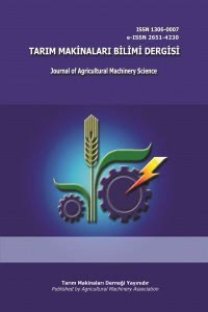Possibilities of Killing Weeds by Microwave Power
Microwave power
Possibilities of Killing Weeds by Microwave Power
Microwave power,
___
- Ark, P. A. and W. Parry, 1940. Application of High-Frequency Electrostatic Fields in Agriculture. The Quarterly Review of Biology. 15(2): 172-191.
- Bebawi, F. F., Cooper, A. P., Brodie, G., Madigan, I., Vitelli, B., Worsley, A., J. S. and Davis, K. M. 2007. Effect of microwave radiation on seed mortality of rubber vine (Cryptostegia grandiflora R.Br.), parthenium (Parthenium hysterophorous L.) and bellyache bush (Jatropha gossypiifolia L.). Plant Protection Quarterly. 22(4): 136- 142.
- Brodie, G., G. Harris, L. Pasma,, A. Travers, , D. Leyson, , C. Lancaster, and J. Woodworth, 2009. Microwave Soil Heating for Controlling Ryegrass Seed Germination.
- Transactions of the American Society of Agricultural and Biological Engineers. 52(1): 295-302.
- Brodie, G., C. Botta, and J. Woodworth, 2007. Preliminary Investigation into Microwave Soil Pasteurization Using Wheat as a Test Species. Plant Protection Quarterly. 22(2): 72-75
- Brodie, G., S. Hamilton, and J. Woodworth, 2007. An Assessment of Microwave Soil Pasteurization for Killing Seeds and Weeds. Plant Protection Quarterly. 22(4): 143-149
- Burnside, O. C., R. S. Moomaw, , F. W. Roeth, , G. A. Wicks, and R. G. Wilson, 1986. Weed Seed Demise in Soil in Weed-Free Crn (Zea mays) Production Across Nabraska. Weed Science. 34(2): 248-251
- Davis, F. S., Wayland, J. R. and Merkle, M. G. 1971. Ultrahigh-Frequency Electromagnetic Fields for Weed Control: Phytotoxicity and Selectivity. Science. 173(3996): 535-537.
- Davis, F. S., J. R. Wayland, and M. G. Merkle, 1973. Phytotoxicity of a UHF Electromagnetic Field. Nature. 241(5387): 291-292.
- Heap, I. M. 1997. The Occurrence of Herbicide-resistant Weeds Worldwide. Pesticide Science. 51(3): 235-243. Kremer, R. J. 1993. Management of Weed Seed Banks with Microorganisms. Ecological Applications. 3(1): 42-52.
- Nelson, S. O. and L. E. Stetson, 1985. Germination Responses of Selected Plant Species to RF Electrical Seed Treatment. Transactions of the ASAE. 28(6): 2051- 2058.
- Nelson, S. O. 1996. A Review and Assessment of Microwave Energy for Soil Treatment to Control Pests. Transactions of the ASAE. 39(1): 281-289.
- Tran, V. N. 1979. Effects of Microwave Energy on the Strophiole, Seed Coat and Germination of Acacia Seeds. Australian Journal of Plant Physiology. 6(3): 277-287.
- Tran, V. N. and A. K Cavanagh. 1979. Effects of Microwave Energy on Acacia Longifolia. Journal of Microwave Power. 14(1): 21-27.
- ISSN: 1306-0007
- Başlangıç: 2005
- Yayıncı: Tarım Makinaları Derneği
Tek Dane Ekici Düzen Performansının Optimizasyonuna Yeni Bir Yaklaşım: Akıllı Vakum Diski*
Şahin DOĞAN, Adnan DEĞİRMENCİOĞLU, Cengiz ÖZARSLAN, Fazilet N. ALAYUNT
Possibilities of Killing Weeds by Microwave Power
Ikbal AYGUN, Engin CAKIR, Koray KACAN
Tarımda Dijital Dönüşüm; İnsansız Hava Araçları Kullanımı
Süleyman TÜRKSEVEN, Mehmet Zeki KIZMAZ, Arif Behiç TEKİN, Erkan URKAN, Ahmet Tansel SERİM
A Review of Electrostatic Spraying for Agricultural Applications
Erkan URKAN, Huseyin GULER, Firat KOMEKCI
Tuncay GÜNHAN, Abdülkadir YAĞCIOĞLU
İleri Yaşlı Çiftçilerin Tarımsal İş Güvenliğine Yaklaşımı
Erdal Öz ÖZ, Gülden ÖZGÜNALTAY ERTUĞRUL
Traktör ve Makina Üç-Nokta Askı Düzeni Boyutlarının Yük Kaldırma Kapasitesine Etkisi*
